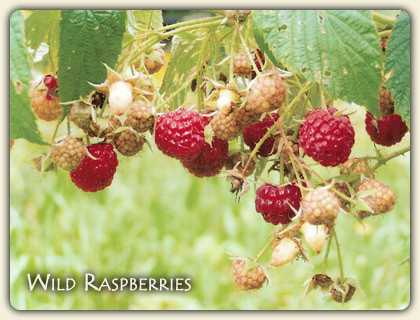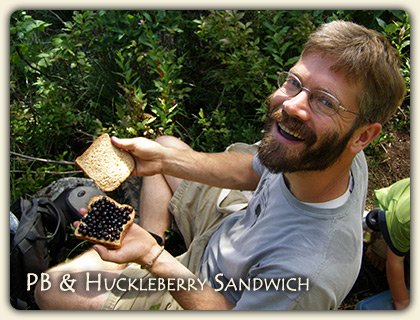Discover Edible Wild Berries!
Discover edible wild berries! Learn all about wild berries right here, including benefits, hazards, types of wild berries, berry identification, harvesting, processing, and more! Berries are truly delightful and it is a memorable experience to identify and eat them. Let's get started!

Benefits of edible wild berries
Not only are edible wild berries a great wild food and substantial addition to your diet, but they're packed with sustenance and energizing to eat as well! For example, blackberries, blueberries, strawberries, raspberries, and cranberries are all rich sources for getting Vitamins C and K into your diet as well as fiber and calcium. These berries rank as the top five fruits for getting the best vitamins and minerals in your diet that protect the cells in your body. Raspberry is even reputed to inhibit cancer. Wow!
Going out to pick edible wild berries and eat them yourself puts you in direct connection with your food. When you are there harvesting those juicy edibles you're given a special opportunity to have magical moments like witness a hummingbird come and eat with you while you are picking or see a deer browsing nearby as well. Moments of connection like this feed the soul. And of course, one of the biggest benefits of edible wild berries is they're fun to pick and they taste delicious!
Hazards – There are poisonous berries out there, too!
There are poisonous berries out there and with one bite it could be all over so make sure you can positively identify the various poisonous berries. Use a field guide and never harvest and eat anything you cannot positively identify. Your field guide should have names, clear pictures and descriptions of the berries you are identifying. When in doubt, don't eat it! Also, make sure to keep an eye out for Poison Ivy while you are out gathering berries!
Types of wild berries
Part of identifying the various types of edible wild berries is organizing your understanding of who's who. It can be helpful in wild berry identification to understand that they're arranged in different groupings like families and genus. Just like we have family members in various groupings, berries do, too! For example, the raspberry, blackberry, salmonberry and thimbleberry plants are all in the same family called Rubus. The bilberry, huckleberry, blueberry and cranberry are all grouped in the same family known as Vaccinium.
Once you start identifying them, you'll see that all the berries in the same family have some things in common and you can begin to look for that. I recommend using Botany in a Day by Thomas Elpel as a reference for learning these families. Now that we've looked at a few types of wild berries, let's go a little deeper into wild berry identification.
Wild berry identification
If you want to learn how to identify wild berries, spend some time studying them. Bring them up close to notice them. Is it a pod, a cluster, a pome or a druplet? Use field guides as a reference, look carefully at the photos and read the descriptions. Separate the plant into its various components and begin by identifying the different parts starting with leaves, flowers, buds, berries and more.
Sometimes studying the seeds of berries can be helpful in identification as well. Some seeds are hard nutlets while others are very soft. The number one rule is eat only those berries you can positively identify. Lastly, get to know where you can find edible wild berries. There are commonalities here. Many of them can be found in low growing areas, bushes, meadows, fields, near rivers and ponds.
Ethical Harvesting – How and when to gather berries
While gathering berries has its immediate rewards, it's important to be sensitive to the whole plant as it has just invested a ton of its life energy to produce these ripe and succulent fruits. When you gather, collect at most 25% of the berries where you are. That way the berries can provide for other people, as well as for the birds and animals that live there.
Gather berries when they are ripe. This is when the berries have developed the best flavor and body to them. You'll know they are ripe because the color will be bright and look vibrant or look dark and matured (depending on the type of berry). At their peak ripeness, often times the berry will separate from the plant with almost no effort at all. Some berries look full and robust and will be hanging heavy from the vine or stalk and the fragrance of some berries can be strong and float in the air above them.
Some berries require plucking their fruits carefully from the plant so they don't get mashed or bruised when you put them in your basket. Other berries have a thick skin around them. By building an intimate connection with these juicy little fruits over time you can let the berries teach you what to do.
Summer and Fall are the best times to identify but spring and winter can also be available seasons depending on the berry. Remember to bring a berry basket with you!
Processing different types of wild berries
Just by spending some time up close with the berries you'll intuitively understand how to process them. In general, if you want to you can rinse or soak the berries in cool water. Sort them by removing any leaves or debris that went into your basket during your harvest. There is no particular order – just do what feels good to you and the berries.
Preserving wild berries
There are as many ways of preserving berries as there are types of them! In general, berries can be dried, frozen or cooked. You can make dried fruit leather, freeze them for smoothies, ice cream, or sorbet, cook them to make jams, jellies, sauces, syrups, vinegars, and even ferment them to make wine. The world is your berry!
By freezing berries you are trapping nutrients and plant chemicals and still retaining a healthy fruit long after the day of the harvest. The secret tip of freezing them is to put them on a cookie sheet first, being mindful of each berry not touching another. After they're frozen put them into plastic bags for the next yearly cycle. That way, they don't freeze together and cause problems later on. If you want to retain the color of the berries you can add a teaspoon or two of lemon juice to the berries before freezing them.
Some edible berries are more suitable for certain recipes and preserving methods than others. For example, blackberries and elderberries make great wine whereas serviceberry and Oregon grape create a delectable jam. Huckleberries make for a killer cheesecake. Try out different recipes to see what you, your family and your friends enjoy!

Yum – Let's eat!
Eating the berries fresh is eating them with the optimal state of nourishment in them. In tasting these berries when they are bursting with flavor one can't help but come to a greater feeling of appreciation for these incredible fruits. I invite you to really savor these delicious jewels before you and remember that they're boosting your life with health and vitality.
There are many ways you can eat them. You can feature them in smoothies, use them in salad dressings like vinagrettes, put them on pancakes, yogurt or breakfast cereal, use them as part of a glaze for roasts or fish, use them to flavor honey, or use them in homemade ice cream. The possibilities are endless!
Resources for edible wild berries
There are many great books written on food plants, many of which include edible wild berries in them. These books will help you in your wild berry identification and in how to cook, eat and preserve them. Here are some basic books we recommend:
- Peterson's Field Guide to Edible Plants
- Newcomb’s Wildflower Guide by Lawrence Newcomb
- Edible and Medicinal Plants of the Rockies by Linda Kershaw
- Food Plants of Interior First People by Nancy J. Turner
When you are out there gathering berries and eating them remember that you are tasting, touching and sensing the wild. Edible wild berries are your portal to greater experiences in nature. We invite you to deepen your connection with the berries and the edibles of the field and forest and remember to share your harvest!
Interested in being personally mentored in Edible Wild Plants, on a transformational journey of connection to nature, community, and self?
Check out the Twin Eagles Wilderness Immersion Program.
comments powered by Disqus
Return from Edible Wild Berries to Edible Wild Plants
Return from Edible Wild Berries to Wilderness Survival (homepage)
Track Us